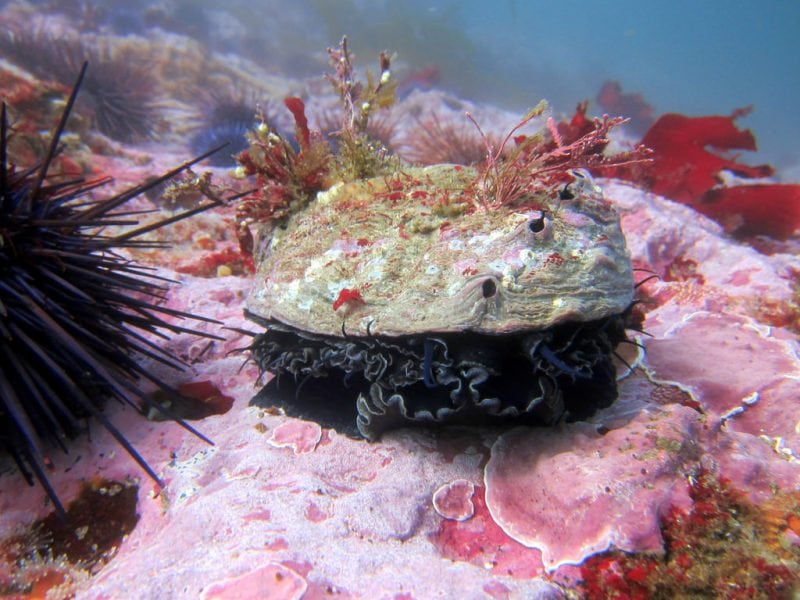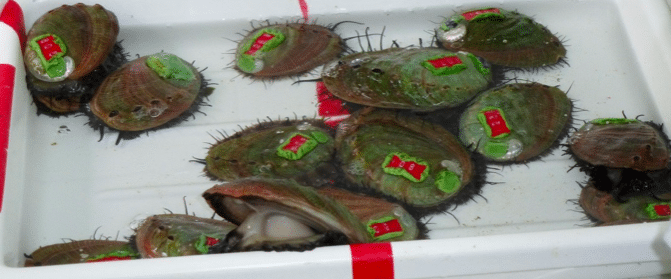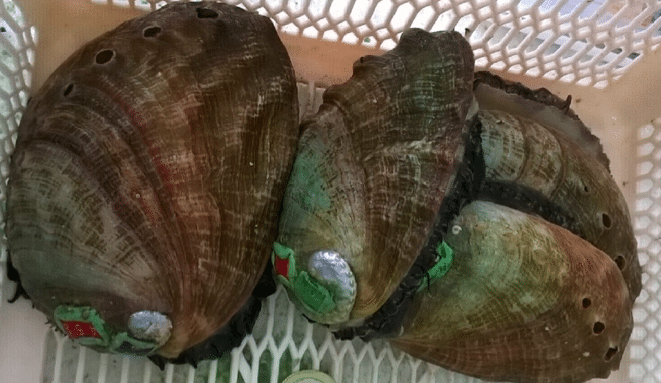
The increase in the human population and the overexploitation of fishery resources means that aquaculture is becoming more important. Projections indicate that all the increase in aquatic animal supply will be completely attributed to aquaculture, where cultured mollusks will dominate by 2030.
Among cultured mollusks, abalones have one of the highest commercial values. There exist ∼100 species of abalones, among which 25 reach an adequate size to be commercially exploited. Large abalones, such as the red abalone Haliotis rufescens, primarily inhabit temperate waters; thus, they are slow-growing, taking 4-8 years to reach commercial size. In addition to slow growth, cost and limited availability of natural food are of main concern for abalone growers. Thus, increasing abalone growth rates and their physiological efficiency in the use of energy through selective breeding could improve abalone production and the industry competitiveness worldwide.
The genetic improvement based on selection has the advantage of being able to generate increases in growth without manipulating genes, but taking advantage of the natural potential of each species. However, for individuals to respond to selection, it is necessary that the performance of the trait to be improved is heritable, that is, that the improvement is transferred from generation to generation.
Growth is a reflection of the internal functioning of individuals, among which the energy balance integrates the basic physiological processes of energy acquisition and allocation. Measurements of the heritability for growth traits in several abalone species, including red abalone, predict responses up to 10% per generation, which augurs well for selective breeding programs for these mollusks. However, the genetic bases underlying individual differences in energy acquisition and allocation, until now were unknown.
Therefore the aim of our study was to estimate the heritable variation of physiological traits associated with energy intake and allocation for the red abalone Haliotis rufescens and the potential correlated responses to selection between growth and physiological traits. When estimating the potential response to selection of the traits of interest, sometimes correlated responses may arise. Two traits are genetically correlated when the variation in one or more genes affects both traits. Therefore, it is important to estimate the magnitude and direction of the genetic correlations between the traits of interest.
We found a significant heritable variation for energy intake through algal consumption; for standard metabolic rate (SMR); and for energy lost by ammonia excretion. Significant heritable variation for growth traits was also found, thus we estimated genetic correlations and potential correlated responses among energy intake and allocation, and growth traits.
In a breeding program, it is important to know if selecting a trait (such as size) is affecting jointly, positively or negatively, other traits controlled by the same genes. This is measured by the sign and magnitude of the genetic correlations. The magnitude of the genetic correlations will indicate how strong the correlated response can be among the other traits evaluated, and the sign of it will indicate if they are inherited in the same or opposite direction.
Our result showed that food intake was negatively and highly genetically correlated with each growth traits (-0.70 to -0.85); and both SMR and ammonia excretion showed high-negative genetic correlations with each growth traits (-0.88 to -1.00). Thus, estimated correlated response to selection indicated that if the selection was exerted for higher growth (choosing 5% best individuals), we would be indirectly selecting for abalones with lower food intake (correlated responses of -11 to -15%); or lower metabolic demands of (-14 to -24%). In turn, shell length could be enhanced up to 18% per generation.
Overall our results suggest that higher growth in red abalone is genetically associated with a more efficient use of food and a lower metabolic demand. The present result is potentially very significant for the profitability and sustainability of abalone farming because two economically relevant aspects such as time to harvest and expenditure in food could be reduced through a selective program for red abalone. Most abalone farms use fresh seaweed (mainly kelp) as feed, but this resource is becoming quite limited because of overexploitation and this constitutes a bottle-neck for increased abalone production. Thus, the possibility to reduce food intake or metabolic demands by selecting for faster-growing abalones would be a very positive development for the sustainability of this culture.
Notes:
- Aquaculture is the activity of farming aquatic organisms.
- The energy budget is an index of the energy available for growth and reproduction, i.e., individual production, is derived from the energetic components of energy balance. Thus, growth differences of animals that share the same environment, e.g., in culture systems, could reflect in part inter-individual differences in: energy acquisition (i.e., food ingestion, absorption and assimilation); allocation of energy for maintenance (i.e., standard metabolism); losses through nitrogenous waste excretion (e.g., ammonia excretion mainly from protein metabolism) and feces production (i.e., unabsorbed food).
- Although there is much information on marine mollusc’s energetic parameters and its application for ecological and aquaculture studies, this is the first study where the genetic control upon physiological traits associated with growth have been estimated through the estimation of their direct heritabilities and potential correlated responses to selection for a marine mollusk.
- Heritability is a central parameter for estimating the response potential to selection of a trait in a population.


Red abalone Haliotis rufescens from the genetic breeding program at Universidad Católica del Norte, Coquimbo, Chile. (Credit: Katherina Brokordt)
These findings are described in the article entitled Heritability of energy intake and allocation and their correlated responses to selection on growth traits in cultured juvenile and adult red abalone Haliotis rufescens, recently published in the journal Aquaculture. This work was conducted by Katherina Brokordt, William J. Farías, Frederico E. Winkler, and Fabio Castaño from the Center for Advanced Studies in Arid Zones (CEAZA) and the Universidad Católica del Norte, and Phillipe Fullsack and Christophe Herbinger from Dalhousie University.









